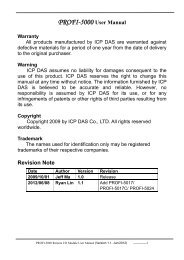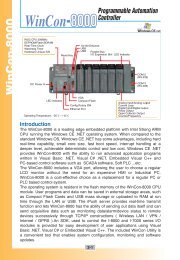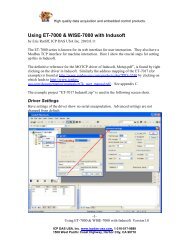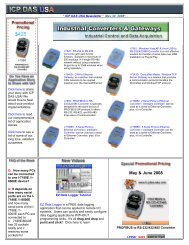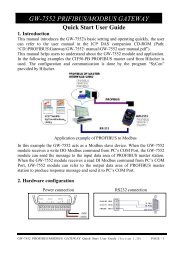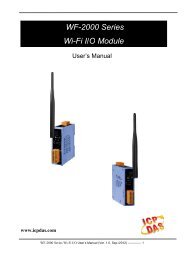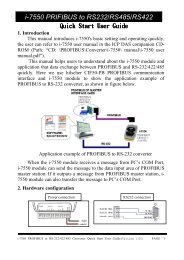Contents - ICP DAS USA
Contents - ICP DAS USA
Contents - ICP DAS USA
Create successful ePaper yourself
Turn your PDF publications into a flip-book with our unique Google optimized e-Paper software.
Networking - FeatureWireless Helps Municipal and Military AgenciesHang-Up on Hardwire CircuitsPaul Mercier, Manager of Business DevelopmentPhoenix Contact, Inc.Countless reasons exist for going wireless, recent fires in California havemotivated several water utility agencies including Rancho Santa Fe IrrigationDistrict in San Diego County, to move away from using hard-wired ortelephone based communication for SCADA and Telemetry applications.Also, the military has been upgrading their infrastructure at bases likeCamp Pendleton which is vast and sprawling complexes where maintainingand expanding wired infrastructure is costly and more labor intensive thangoing with wireless solutions. The purpose of this article is to compareand contrast traditional wired sensor and pump/valve controller applicationswith wireless alternatives for engineers, operators and maintenancepersonnel to consider as they face the challenge of migrating from old tonew technologies.Today’s engineers and specialized technicians are not as interested inthe technology that makes wireless work, but rather in the proper applicationand use of radio technologies. In basic terms, “What do I use, wheredo I use it, and how do I use it?” are right up there in most frequently askedquestions alongside “How far will it go?” and “Is it reliable, trustworthyand secure?”Wireless technology is part of our everyday lives in the home andoffice. In recent years, this technology has made the logical progressionfrom the home and office into the municipal and military facilities world,onto the treatment plant floor and into the field. It adds convenience,reduces installation time and provides solutions to common problems.Replacing or eliminating cables with wireless technology has many attractivefeatures beyond the obvious installation speed (hours versus days/weeks) and cost savings (labor, permits, material). However, there is stillan ongoing debate about the level of trust in using wireless products for acontrol-based application.Wireless ReliabilityWireless modems and radio telemetry devices have been used in controlsystems of mission critical pumps for more than 30 years, yet fear of the unknownremains. There have been thousands of successful wireless SCADAimplementations for water/wastewater, gas pipeline and utilities that requiredata delivered in an acceptable one to two seconds. It is important to notethe difference between a deterministic, or time-critical, application and onethat requires only high data reliability.The nature of the RF environment dictates that there is no absoluteguarantee that any given piece of data will successfully be transmitted andreceived over the air. However, a well-designed radio will have builtinerror checking and retry capabilities that continue sending a piece ofinformation until it is successfully received. This makes it possible to sendimportant data over a wireless link, as long as the entire system can toleratesome amount of latency or delay.Wireless AdvantagesA wireless hybrid network, or combination of technologies like thatused at RSFID can provide technical advantages and cost benefits for pumpmonitoring and pressure reducing valve control applications. Installingwireless systems to replace both communication and sensor signal cablingcan reduce the time it takes to engineer and develop the expansion orconstruction of a pumping plant. The Witch Creek fire in North County tookout phone lines into critical sites in the RFSID system leaving them withoutcommunication to check and control when needed most.“We wanted to go wireless in numerous areas and applications so wewould be autonomous from telephone company in case of wildfires andearthquakes,” said Eli Standing Warrior, RSFID Maintenance Supervisor.Jim Gingrich, Lead Maintenance specialist at the District, stated, “Thereis a ROI of less than two years as each leased line to remote sites averaged$120 a month. We also saved over $15,000using wireless over installing a fiber link toprovide a LAN bridge of the SCADA HMIfrom the R.E. Badger Treatment plant to thedistrict maintenance yard three miles away.”The operators at the yard can now keeptabs on their critical pump stations, improvingresponse times and maintenance efficiencies.The up-front cost of a wireless system isoften immediately lower than cabling and conduitcosts, and the savings in labor and permitsare enormous. A signal that previously tookdays to bring online using traditional wiringcan now be commissioned within hours. Withthis time savings and flexibility, maintenancecrews can deploy wireless nodes for temporarytroubleshooting or adding stranded measurementpoints and streamlining asset managementstrategies.Maintenance yard three miles fromWLAN antenna at Rancho Santa FeTo monitor and control pumps remotely, plant. Extending SCADA workstation.most companies communicate over fiber,copper or some hard-wired cable. Ideally, important sensors that monitorsuction/discharge pressure, tank levels, system pressure, flow rates andtemperatures can be tied back to the pump controller via wire. A hardwirednetwork of pump control panels is also ideal, if it can communicatecost-effectively.But in a world that isn’t always ideal, wireless can be the next best thingto wire. In fact, many locations have found wireless connections provide amore reliable connection than a wired circuit.Managing lift stations is one of the biggest problems water utility operatorsface. Lift stations are built-in remote locations spread out around citiesand business areas. A lift station typically includes two pumps that pumpsewage into massive underground tanks. Over time, clogging or infiltrationcan reduce a pump’s efficiency, until eventually the pump stops operating.When a pump stops, the old-fashioned, flashing light system alarms thesite, however, at this point, it might be too late. Diagnosing and repairingthe problem might take too long, causing spillage to occur. Often the pumpsdo not completely fail, rather they lose efficiency. Older systems will allowthe anomaly to go unnoticed until a spill is detected by residents or someother means. Spills reported by the public often lead to fines, lawsuits andeven criminal charges for the wastewater engineer or superintendent.Tougher EPA and Clean Water legislation have dramatically increasedthe need for the monitoring and control of sewage collection systems.A spill occurs every day somewhere in America. It can cost $50,000 to$100,000, not to mention the seemingly irreparable environmental damage.The cost includes the price ofpumping out the lift station, newpumps, rush shipping of parts,area cleanup, overtime andother ancillary charges. Wirelesspump control products canprevent a spill altogether, whichreduces down times and keeps a“lid” on a problem before it hitsthe headlines.New RTU at Camp Pendleton sewage lift stationreplacing chart recorders and phone telemetry withwireless solution.For example, Camp Pendletonfaced a challenging datacommunications problem. Thebase has pumping equipmentand wastewater units at approximately129 unattended locations. It used chart recorders, obsolete RTU’sand a telephone link to a single computer to monitor and control all of thesesites. Officials needed better information about the status of the remote16 www.RemoteMagazine.com



